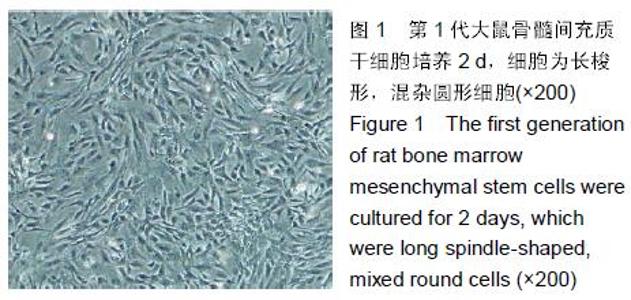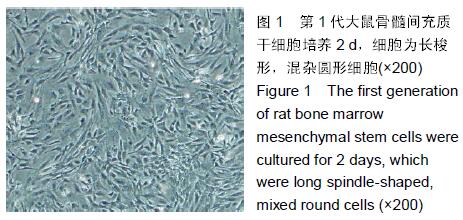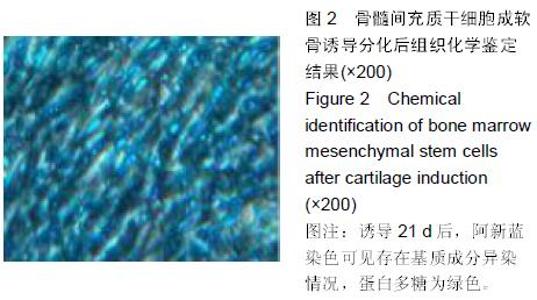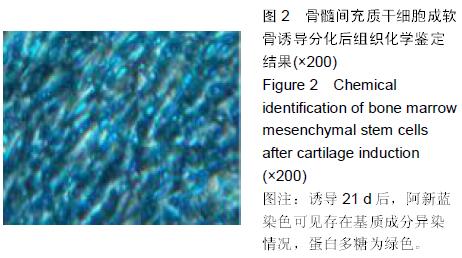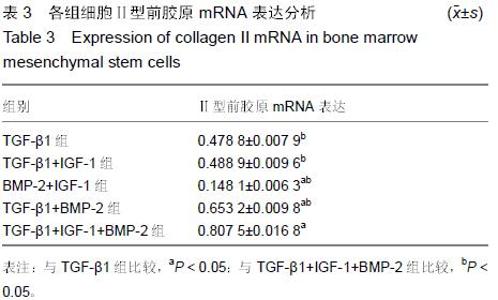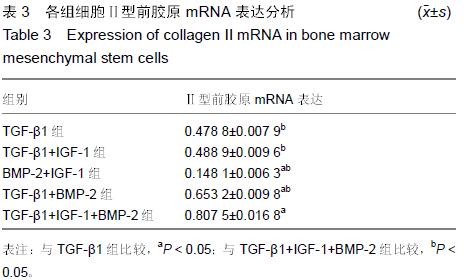Chinese Journal of Tissue Engineering Research ›› 2015, Vol. 19 ›› Issue (45): 7237-7241.doi: 10.3969/j.issn.2095-4344.2015.45.004
Previous Articles Next Articles
Chondrogenic differentiation of bone marrow mesenchymal stem cells induced by different growth factors
Wang Shu-ying1, Lu Xiao-bing2, Ouyang Lin3
- 1Wulanchabu Medical College, Wulanchabu 012000, Inner Mongolia Autonomous Region, China; 2Changzhou Second People’s Hospital Affiliated to Nanjing Medical University, Changzhou 213003, Jiangsu Province, China; 3Department of of Histology and Embryology, Inner Mongolia Medical University School of Basic Medicine, Hohhot 010110, Inner Mongolia Autonomous Region, China
-
Received:2015-10-06Online:2015-11-05Published:2015-11-05 -
About author:Wang Shu-ying, Wulanchabu Medical College, Wulanchabu 012000, Inner Mongolia Autonomous Region, China
Cite this article
Wang Shu-ying, Lu Xiao-bing, Ouyang Lin. Chondrogenic differentiation of bone marrow mesenchymal stem cells induced by different growth factors[J]. Chinese Journal of Tissue Engineering Research, 2015, 19(45): 7237-7241.
share this article
|
[1] Wu J, Wang F, Yang L, et al. Chondrocytic biomimetic matrix materials-induced differentiation of rat bone marrow mesenchymal stem cells into chondrocyte-like cells in vitro.Xi Bao Yu Fen Zi Mian Yi Xue Za Zhi. 2015;31(11): 1502-1505.
[2] Liu P, Sun L, Chen H, et al. Lentiviral-mediated multiple gene transfer to chondrocytes promotes chondrocyte differentiation and bone formation in rabbit bone marrow-derived mesenchymal stem cells. Oncol Rep. 2015;34(5):2618-2626.
[3] Zhang X, Hirai M, Cantero S, et al. Isolation and characterization of mesenchymal stem cells from human umbilical cord blood: reevaluation of critical factors for successful isolation and high ability to proliferate and differentiate to chondrocytes as compared to mesenchymal stem cells from bone marrow and adipose tissue. J Cell Biochem. 2011;112(4):1206-1218.
[4] Murphy MK, Huey DJ, Hu JC, et al. TGF-β1, GDF-5, and BMP-2 stimulation induces chondrogenesis in expanded human articular chondrocytes and marrow-derived stromal cells. Stem Cells. 201533(3):762-773.
[5] Wang H, Li Y, Chen J, et al. Chondrogenesis of bone marrow mesenchymal stem cells induced by transforming growth factor beta3 gene in Diannan small-ear pigs.Zhongguo Xiu Fu Chong Jian Wai Ke Za Zhi. 2014;28(2):149-154.
[6] Wang F, Zhang YC, Zhou H, et al. Evaluation of in vitro and in vivo osteogenic differentiation of nano-hydroxyapatite/ chitosan/poly(lactide-co-glycolide) scaffolds with human umbilical cord mesenchymal stem cells. J Biomed Mater Res A. 2014;102(3):760-768.
[7] 甘凤英.生长因子联合诱导大鼠骨髓间充质干细胞向软骨分化的实验研究[D].福州:福建医科大学,2006.
[8] Bosnakovski D, Mizuno M, Kim G, et al. Chondrogenic differentiation of bovine bone marrow mesenchymal stem cells (MSCs) in different hydrogels: influence of collagen type II extracellular matrix on MSC chondrogenesis. Biotechnol Bioeng. 2006;93(6):1152-1163.
[9] 周瑜.慢病毒介导TGF-β3/BMP-2联合基因转染诱导兔骨髓间充质干细胞软骨分化的实验研究[D]. 青岛:青岛大学,2014.
[10] 周瑜,夏长所,王昌耀,等.慢病毒介导TGF-β3/BMP-2联合基因转染诱导兔骨髓间充质干细胞成软骨细胞分化[J].中华临床医师杂志:电子版,2014,8(4):688-694.
[11] Dahlin RL, Meretoja VV, Ni M, et al. Chondrogenic phenotype of articular chondrocytes in monoculture and co-culture with mesenchymal stem cells in flow perfusion. Tissue Eng Part A. 2014;20(21-22):2883-2891.
[12] Liu S, Zhang E, Yang M, et al. Overexpression of Wnt11 promotes chondrogenic differentiation of bone marrow-derived mesenchymal stem cells in synergism with TGF-β. Mol Cell Biochem. 2014;390(1-2):123-131.
[13] Moghadam FH, Tayebi T, Dehghan M, et al. Differentiation of bone marrow mesenchymal stem cells into chondrocytes after short term culture in alkaline medium. Int J Hematol Oncol Stem Cell Res. 2014;8(4):12-19.
[14] 刘吉斌,侯连东,于强,等.骨膜复合骨髓间充质干细胞和软骨细胞体内移植修复软骨缺损[J].中国组织工程研究,2015,19(3): 364-369.
[15] Zhang Z, Wang Y, Li M, et al. Fibroblast growth factor 18 increases the trophic effects of bone marrow mesenchymal stem cells on chondrocytes isolated from late stage osteoarthritic patients. Stem Cells Int. 2014;2014:125683.
[16] Leyh M, Seitz A, Dürselen L, et al. Subchondral bone influences chondrogenic differentiation and collagen production of human bone marrow-derived mesenchymal stem cells and articular chondrocytes.Arthritis Res Ther. 2014;16(5):453.
[17] Wang J, Li J, Deng N, et al. Transfection of hBMP-2 into mesenchymal stem cells derived from human umbilical cord blood and bone marrow induces cell differentiation into chondrocytes. Minerva Med. 2014;105(4):283-288.
[18] 陈伟,王丽娜,郝云甲,等.不同来源软骨细胞共培养对骨髓间充质干细胞早期分化的影响[J].中华老年医学杂志,2015,34(5): 557-560.
[19] 李斌,华永新,曲华正,等.软骨细胞和骨髓间充质干细胞相关基因转染的研究进展[J].医学与哲学,2014,35(24):58-61.
[20] 李斌,张伟,王健,等.体外微团培养兔骨髓间充质干细胞形成软骨细胞[J].中国矫形外科杂志,2009,17(23):1819-1822.
[21] Nixon AJ, Fortier LA, Williams J, et al. Enhanced repair of extensive articular defects by insulin-like growth factor-I-laden fibrin composites. J Orthop Res. 1999;17(4):475-487.
[22] Sekiya I, Larson BL, Vuoristo JT, et al. Comparison of effect of BMP-2, -4, and -6 on in vitro cartilage formation of human adult stem cells from bone marrow stroma. Cell Tissue Res. 2005;320(2):269-276.
[23] Olmez U, Ryan LM, Kurup IV, et al. Insulin-like growth factor-1 suppresses pyrophosphate elaboration by transforming growth factor beta1-stimulated chondrocytes and cartilage. Osteoarthritis Cartilage. 1994;2(3):149-154.
[24] Reyes R, Pec MK, Sánchez E, et al. Comparative, osteochondral defect repair: stem cells versus chondrocytes versus bone morphogenetic protein-2, solely or in combination Eur Cell Mater. 2013;25:351-365.
[25] Wu L, Leijten J, van Blitterswijk CA, et al. Fibroblast growth factor-1 is a mesenchymal stromal cell-secreted factor stimulating proliferation of osteoarthritic chondrocytes in co-culture. Stem Cells Dev. 2013;22(17):2356-2367.
[26] Sabatino MA, Santoro R, Gueven S, et al. Cartilage graft engineering by co-culturing primary human articular chondrocytes with human bone marrow stromal cells. J Tissue Eng Regen Med. 2012 Dec 6. [Epub ahead of print]
[27] Tang X, Sheng L, Xie F, et al. Differentiation of bone marrow-derived mesenchymal stem cells into chondrocytes using chondrocyte extract. Mol Med Rep. 2012;6(4):745-749.
[28] Liao X, Wu L, Fu M, et al. Chondrogenic phenotype differentiation of bone marrow mesenchymal stem cells induced by bone morphogenetic protein 2 under hypoxic microenvironment in vitro.Zhongguo Xiu Fu Chong Jian Wai Ke Za Zhi. 2012;26(6):743-748.
[29] Kocamaz E, Gok D, Cetinkaya A, et al. Implication of C-type natriuretic peptide-3 signaling in glycosaminoglycan synthesis and chondrocyte hypertrophy during TGF-β1 induced chondrogenic differentiation of chicken bone marrow-derived mesenchymal stem cells. J Mol Histol. 2012;43(5):497-508.
[30] 冯万文,夏亚一,孙正义,等.骨髓间充质干细胞和软骨细胞共培养复合同种异体脱钙骨基质修复关节软骨全层缺损[J].第四军医大学学报,2006,27(18):1683-1686.
[31] 张文元,杨亚冬,房国坚,等.大鼠骨髓间充质干细胞的分离冻存及向成骨细胞和软骨细胞诱导分化[J].中国现代医学杂志,2006, 16(9):1306-1309.
[32] Gronthos S, McCarty R, Mrozik K, et al. Heat shock protein-90 beta is expressed at the surface of multipotential mesenchymal precursor cells: generation of a novel monoclonal antibody, STRO-4, with specificity for mesenchymal precursor cells from human and ovine tissues. Stem Cells Dev. 2009;18(9):1253-1262.
|
| [1] | Lin Qingfan, Xie Yixin, Chen Wanqing, Ye Zhenzhong, Chen Youfang. Human placenta-derived mesenchymal stem cell conditioned medium can upregulate BeWo cell viability and zonula occludens expression under hypoxia [J]. Chinese Journal of Tissue Engineering Research, 2021, 25(在线): 4970-4975. |
| [2] | Pu Rui, Chen Ziyang, Yuan Lingyan. Characteristics and effects of exosomes from different cell sources in cardioprotection [J]. Chinese Journal of Tissue Engineering Research, 2021, 25(在线): 1-. |
| [3] | Zhang Tongtong, Wang Zhonghua, Wen Jie, Song Yuxin, Liu Lin. Application of three-dimensional printing model in surgical resection and reconstruction of cervical tumor [J]. Chinese Journal of Tissue Engineering Research, 2021, 25(9): 1335-1339. |
| [4] | Hou Jingying, Yu Menglei, Guo Tianzhu, Long Huibao, Wu Hao. Hypoxia preconditioning promotes bone marrow mesenchymal stem cells survival and vascularization through the activation of HIF-1α/MALAT1/VEGFA pathway [J]. Chinese Journal of Tissue Engineering Research, 2021, 25(7): 985-990. |
| [5] | Shi Yangyang, Qin Yingfei, Wu Fuling, He Xiao, Zhang Xuejing. Pretreatment of placental mesenchymal stem cells to prevent bronchiolitis in mice [J]. Chinese Journal of Tissue Engineering Research, 2021, 25(7): 991-995. |
| [6] | Liang Xueqi, Guo Lijiao, Chen Hejie, Wu Jie, Sun Yaqi, Xing Zhikun, Zou Hailiang, Chen Xueling, Wu Xiangwei. Alveolar echinococcosis protoscolices inhibits the differentiation of bone marrow mesenchymal stem cells into fibroblasts [J]. Chinese Journal of Tissue Engineering Research, 2021, 25(7): 996-1001. |
| [7] | Fan Quanbao, Luo Huina, Wang Bingyun, Chen Shengfeng, Cui Lianxu, Jiang Wenkang, Zhao Mingming, Wang Jingjing, Luo Dongzhang, Chen Zhisheng, Bai Yinshan, Liu Canying, Zhang Hui. Biological characteristics of canine adipose-derived mesenchymal stem cells cultured in hypoxia [J]. Chinese Journal of Tissue Engineering Research, 2021, 25(7): 1002-1007. |
| [8] | Geng Yao, Yin Zhiliang, Li Xingping, Xiao Dongqin, Hou Weiguang. Role of hsa-miRNA-223-3p in regulating osteogenic differentiation of human bone marrow mesenchymal stem cells [J]. Chinese Journal of Tissue Engineering Research, 2021, 25(7): 1008-1013. |
| [9] | Lun Zhigang, Jin Jing, Wang Tianyan, Li Aimin. Effect of peroxiredoxin 6 on proliferation and differentiation of bone marrow mesenchymal stem cells into neural lineage in vitro [J]. Chinese Journal of Tissue Engineering Research, 2021, 25(7): 1014-1018. |
| [10] | Zhu Xuefen, Huang Cheng, Ding Jian, Dai Yongping, Liu Yuanbing, Le Lixiang, Wang Liangliang, Yang Jiandong. Mechanism of bone marrow mesenchymal stem cells differentiation into functional neurons induced by glial cell line derived neurotrophic factor [J]. Chinese Journal of Tissue Engineering Research, 2021, 25(7): 1019-1025. |
| [11] | Duan Liyun, Cao Xiaocang. Human placenta mesenchymal stem cells-derived extracellular vesicles regulate collagen deposition in intestinal mucosa of mice with colitis [J]. Chinese Journal of Tissue Engineering Research, 2021, 25(7): 1026-1031. |
| [12] | Pei Lili, Sun Guicai, Wang Di. Salvianolic acid B inhibits oxidative damage of bone marrow mesenchymal stem cells and promotes differentiation into cardiomyocytes [J]. Chinese Journal of Tissue Engineering Research, 2021, 25(7): 1032-1036. |
| [13] | Wang Xianyao, Guan Yalin, Liu Zhongshan. Strategies for improving the therapeutic efficacy of mesenchymal stem cells in the treatment of nonhealing wounds [J]. Chinese Journal of Tissue Engineering Research, 2021, 25(7): 1081-1087. |
| [14] | Wang Shiqi, Zhang Jinsheng. Effects of Chinese medicine on proliferation, differentiation and aging of bone marrow mesenchymal stem cells regulating ischemia-hypoxia microenvironment [J]. Chinese Journal of Tissue Engineering Research, 2021, 25(7): 1129-1134. |
| [15] | Zeng Yanhua, Hao Yanlei. In vitro culture and purification of Schwann cells: a systematic review [J]. Chinese Journal of Tissue Engineering Research, 2021, 25(7): 1135-1141. |
| Viewed | ||||||
|
Full text |
|
|||||
|
Abstract |
|
|||||
